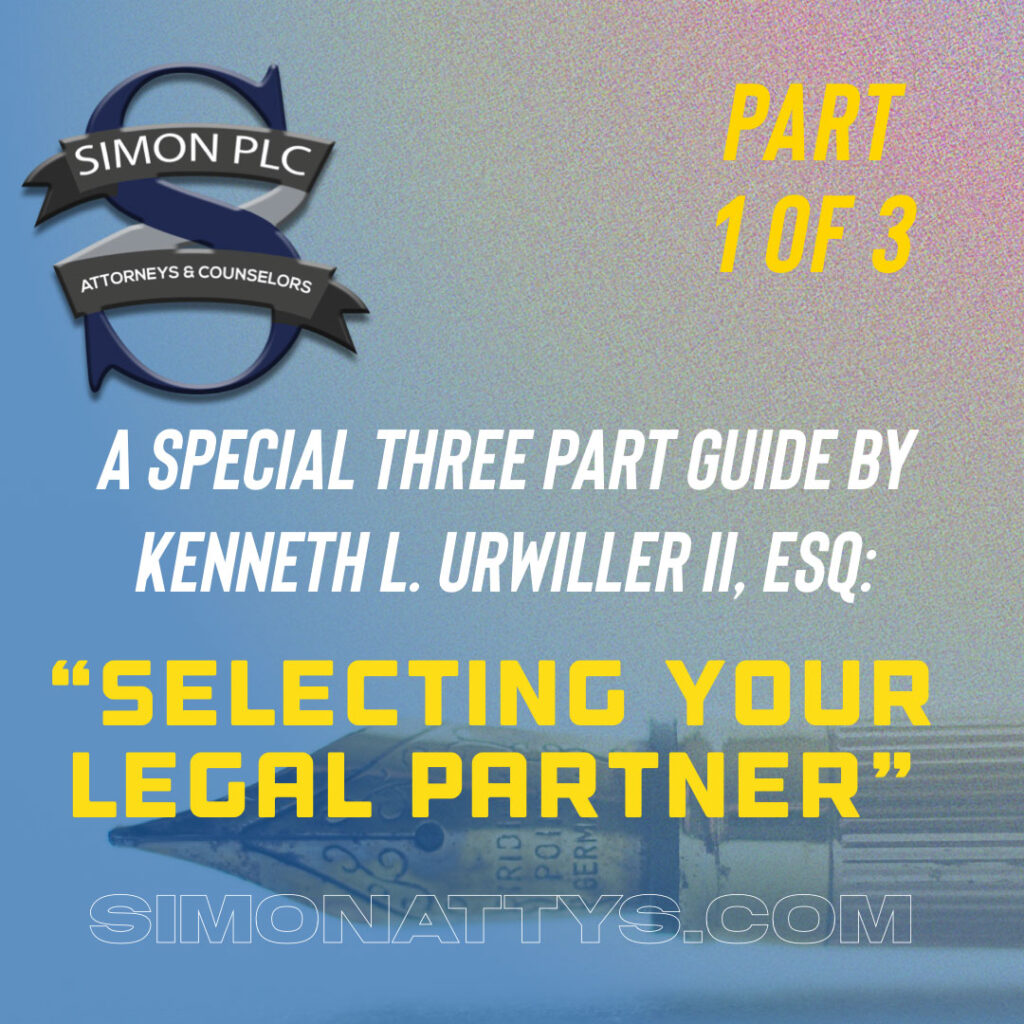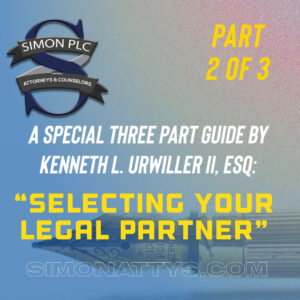Simon PLC Attorneys & Counselors – April 2022 Special Memorandum
Troy, Michigan – At many times in its history, our Firm has been honored to employ current and former in-house counsel from financial institutions as Senior Attorneys at the Firm. Our clients, and the Firm alike, have always benefitted from their insights and experience to make sure we deliver efficient and value-added legal advice which recognizes the customer, budget and cost center demands of our clients. Kenneth L. Urwiller II, Esq is one such valued member of our Team. With an outstanding career working for local Michigan and ultimately National Bank Associations, Ken brings his particular knowledge to the daily matters encountered by our clients. In 2022 Ken has begun the process of sharing his thoughts and approaches in order to help banks and credit unions assess their litigation needs. In the coming three months we are proud to share, and republish with Ken’s permission, his excellent three-part series on ‘Selecting Your Legal Partner’.
This month’s installment begins with an analysis of your institution’s litigation culture. In the next installment (publishing May 1, 2022), Ken breaks down litigation philosophies in Part 2. – How do you litigate? And the final installment (publishing June 1, 2022), Part 3 – Making Your Selections, Ken provides his insights on picking the right firm for your institution’s needs.
Please enjoy and share Ken’s thoughts with your colleagues.
Selecting Your Legal Partner
© Kenneth L. Urwiller, Esq.
Part 1 – What’s your litigation culture?
By Kenneth Urwiller II, Senior Attorney
The worst time to find a suitable legal partner for your bank or credit union is when you’re facing a significant legal or regulatory risk issue. This is even more true for litigation matters because time is of the essence as filing deadlines are looming. But if your bank or credit union does not have a legal department or General Counsel, how do you approach litigation matters? How can you avoid this problem, alleviate the stress it creates and find the best legal partner for your organization?
It’s important to be diligent when you research and select legal counsel for your organization, and to make these selections before you will need their services. But it’s also critical to know who you are before you begin your search.
Define your culture
Your aim is to match the litigation expertise and approach of any legal partner to the culture and philosophy of your institution. But what is your culture and philosophy? What does your institution stand for, believe in? What are your values, vision and mission statement? If you are unsure of these things, examine your website. Analyze your social media posts and other media articles to learn how your organization’s values and visions are articulated. Is the organization portrayed as traditional or progressive, conservative or aggressive? Is your outstanding customer service front and center? Do you emphasize your community responsibility? Once you understand your culture, you can begin the process to assess your litigation tolerances and philosophy.
Define Litigation Risk, Expense and Time Tolerances
We begin this process by first defining litigation tolerances. There are a number of tolerances involved in the litigation process. We’ll focus on three: risk tolerance, expense tolerance and time tolerance. Specifically, this is an institution’s comfort level of accepting the potential risk of the results, expense it must bear and time that it takes to effectively prosecute or defend a lawsuit.
Litigation risk tolerance involves the probability or possibility that the organization will incur liability and/or be exposed for improper or ineffective policies, procedures or training. Litigation risk tolerance is different from general business risk tolerance. Practically every function a financial institution performs, regardless of size, involves business risk: every deposit it accepts, every withdrawal it allows, every loan it makes. Every organization’s management is well versed in this type of risk. Conversely, management doesn’t manage litigation risk every day. This type of risk entails information and advice from outside sources and final determinations are not made by employees and management, but by less predictable judges and unpredictable juries.
Litigation expense tolerance is the organization’s patience to incur litigation fees and expenses to appropriately prosecute or defend a case. Expenses like attorney fees, expert fees, obtaining and reviewing information from the opposing side and producing information for opponents are significant expenses. They can test the dedication of management to properly continue to prosecute or defend a case.
Litigation time tolerance is the institution’s stamina to remain committed throughout the protracted litigation process. Litigation takes months, even years, to resolve or conclude. The energy demanded to participate in this grueling process takes its toll on everyone. As time passes and expenses mount, potential resolutions evaporate and patience deteriorates. This can test institutional resources and management’s determination to complete the process.
Perform Some Internal Due Diligence
Now that you understand some important litigation tolerances, the next step is to undertake some due diligence on your institution. Start by examining your recent customer complaints and litigation cases. How many complaints and cases you review is up to you. You will need enough information to allow you to identify some trends. Make sure to work with your finance or accounting areas to include the legal expenses associated with the identified matters, and at a minimum identify the:
- type of claim or the issue,
- amount of the claim,
- date the claim was opened and the date it was closed,
- amount paid or action taken to resolve the matter,
- litigation expenses to defend or prosecute the claim, and
- policies, procedures or training involved
How you collect and organize your information is up to you. There are many brands of data management software you can purchase to meet your specific needs. However, if you choose to use a simple spreadsheet to collect and organize your information, you can collect the data by using a column for each piece of information (e.g. a column for type of claim, for amount claimed, for date opened, date closed, liability, expenses etc.). After you have collected all your data you can sort by columns to make some determinations.
The type of cases or issues could include deposit side issues such as account opening documentation difficulties, improper deposit account withdrawals, accepting altered, forged or counterfeit checks. Other examples include lending side issues such as loan agreement disputes, foreclosures and collections or any of the innumerable federal and state deposit and lending regulations. Keep in mind that there may be more than one issue or claim per customer complaint or case.
Decide upfront if you want to list the amount of the complaint or claim by the amount of the actual dispute or the amount claimed by the customer or plaintiff. This is important because plaintiff’s often claim all types of damages that are not recoverable such as attorney fees, lost wages and pain and suffering. Including these costs can affect your conclusions.
When entering the date the matter was opened and closed, make sure to input the month, day and year. That way you can determine the time it takes to resolve matters by the number of days the matter is open. This will provide you with a measurable time against which you can compare individual matter resolutions times by claim type, department or policy/procedure involved. For litigation, try to clarify the point in the process the dispute was resolved. Was it early, middle or late?
When you record the policy, procedure or training involved, make certain to link them to the matter issues. Be specific regarding what portion(s) of the policy, procedure, training or employee action is involved. For example, you might find several check cases where branch employees failed to follow your deposit review procedure. Determine the portion of the procedure that resulted in the case such as the failure to verify endorsement(s), the failure to examine the check front for alternation or the failure to adhere to the institution’s “know your customer” procedures etc.
Detail the results or terms it took to resolve the complaint or litigation. Did you pay money or forgive fees or other debt? If so, how much? If no, document that too. Did you take corrective action? If so, what type?
Organize Your Due Diligence
When you have completed gathering your data, organize it according to your specific needs and circumstances. If you use the spreadsheet method, you can sort your columns to gather some initial determinations. For example, you can separate your disputes by issues type, department, time to resolve, policy or procedure disputed and amount of liability and expenses incurred. These simple data sorts can provide you with significant information on such questions as: what are your most common types of issues, what area, product or service is generating the disputes, how long is it taking you to resolve disputes, what issues are more difficult to resolve and how much expense is it taking you to resolve your disputes. If you have enough data, you can create overall averages for time and expense and compare individual cases or types of matters to those averages. These are just a few examples of the types of initial determinations you can generate from your due diligence. Your goal will be to organize your data so when you complete your analysis you can draw conclusions regarding your most problematic transactions, costly issues and most time-consuming matters to name a few. Now you are ready to re-examine your assessments regarding your institutional culture. Does the information obtained through your customer complaint and case history review confirm your initial determinations or alter them in any way? Once your data is organized and you have obtained some initial determinations, you’re ready to focus on identifying the bank or credit union’s tolerances and litigation philosophy.
Up Next
Using the information you’ve gathered, organized and initially reviewed, you can determine what type of litigator your institution is. We’ll explore four common litigation philosophies and offer tips to help you determine your litigation philosophy.
[Publishing May 1, 2022 Part 2. – How do you litigate? ]
The information contained herein is not legal advice or meant to be an exhaustive discussion of all aspects of the subject matter. It is meant solely as an introductory dialogue to assist banks and credit unions without a legal department or internal counsel to establish an approach to litigation matters.
N.B. Not Legal Advice: Please contact us if you would like to discuss the facts and circumstances of your specific matter. Simon PLC Attorneys & Counselors expressly disclaims all liability in respect to actions taken or not taken based on any or all the contents of this memorandum. The information contained herein may not reflect current legal developments and is provided without any knowledge as to the recipient’s location, industry, identity or specific circumstances. No recipients of this content, clients or otherwise, should act, or refrain from acting, on the basis of any content included in this memorandum without seeking the appropriate legal or other professional advice on the particular facts and circumstances at issue from an attorney licensed in the jurisdiction for which the recipient’s legal issue(s) involve. The application and impact of relevant laws varies from jurisdiction to jurisdiction, and our attorneys do not seek to practice law in states, territories and foreign countries where they are not properly authorized to do so.


